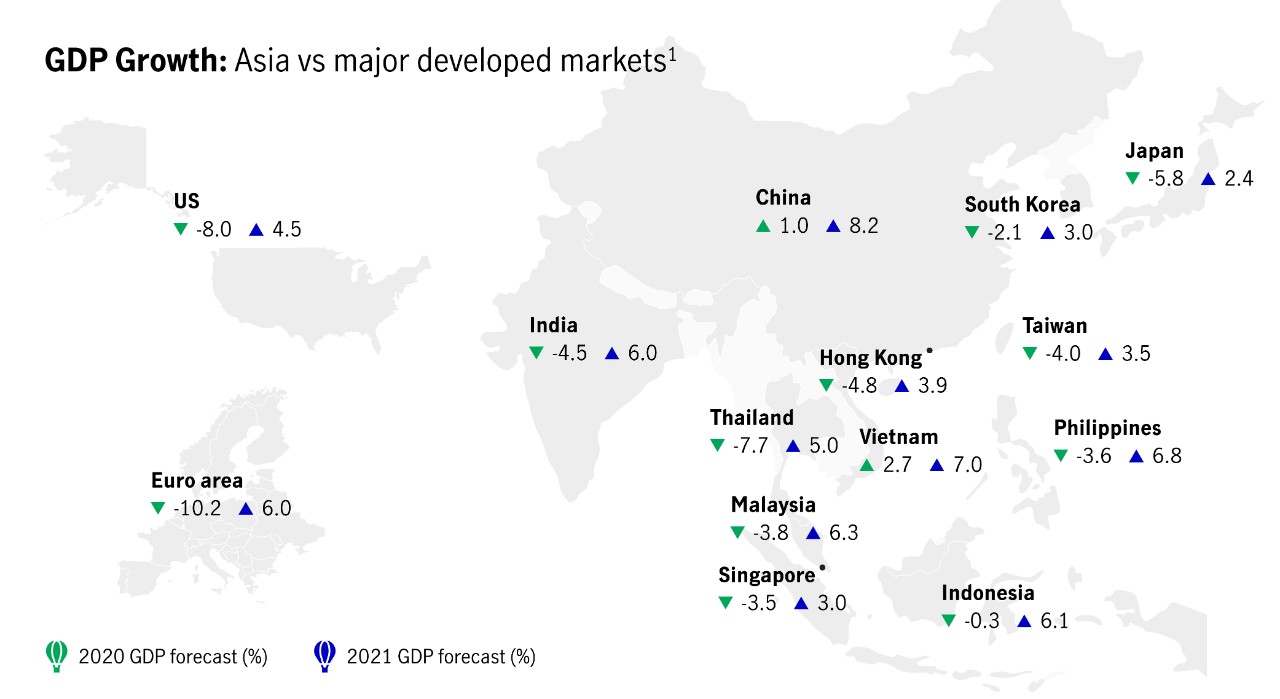
Sometimes we all need to step outside for a moment, take some air and review the situation with a calm head and a clear focus. This is undoubtedly true right now, as the economic disruption and market volatility generated by the pandemic plus the associated negative news flow is creating a barrier that makes it harder to see the bigger picture.
Let’s pause, then, and look at the facts from an Asian perspective. The first thing to point out is that Asia, as a region, is not homogenous, and recent events from trade tensions to the pandemic have affected different markets in a variety of ways. The truth is, the picture is not universally negative. In our view it is to say that some markets, such as Hong Kong and Singapore, endured greater short-term pain than others. But it may also surprise you to know that some markets (China, Vietnam and Indonesia) should emerge from the “crisis” with their GDP for 2020 in positive, or close to positive, territory (see chart below).

The case for liquid real assets in a shifting inflation regime
For over a decade, global investors operated under the assumption that inflation would remain subdued, anchored below 2% - a belief reinforced by central bank credibility and structural disinflationary forces like globalisation and technological deflation. However, the post-pandemic world has ushered in a new regime of structurally higher inflation risks, with evolving policy responses that make liquid real assets increasingly attractive.
Greater China Equities: Perspective for Q4 2025
Heading into the final quarter of the year, we remain constructive, supported by the US Federal Reserve interest rate cutting cycle, Mainland’s demand-side stimulus, strategic priorities outlined in the 15th Five-Year Plan, continued recovery in corporate earnings and robust fund inflows.
Q&A: Potential market impact of a US government shutdown
The US Senate failed to pass a last-minute funding deal, triggering the first federal government shutdown in nearly seven years starting from 1 October. Our Multi-Asset Solutions Team shares insights on how markets have responded during past shutdowns, and how investors can position themselves amid the uncertainty.
Once we move into 2021, it seems most markets in Asia will likely enjoy robust GDP growth, led again by the emerging territories that will be bolstered by the strength of their underlying economic fundamentals.
Although GDP is a measure of what has gone before, and investors invariably look to the future, a period of healthy growth does instil confidence. It can encourage people to participate in the market – especially when they see economic expansion resulting in improving company earnings and, consequently, rising prices.
In our view it is also true to say that a flourishing portfolio is a well-diversified one. Currently, many people prefer to invest in their home market, as this is where their comfort zone lies. However, with confidence rising in the economic prospects and diversity of the wider Asian region, we believe investors now have an opportunity to spread their wings and explore other markets. We expect this would deliver greater portfolio diversification through exposure to different markets, asset classes, sectors and industries.
Earlier, we noted that despite a lack of clarity on the bigger picture, our daily lives will still go on. As such, one should remain cool and calm to face any challenges, plan for the future, and maintain diversification.
1 Source: Government websites, as of 22 July 2020. International Monetary Fund – World Economic Outlook Update, April 2020 and June 2020. 2020 Q1 actual GDP: Vietnam: 3.82%; India: 3.1%; Indonesia: 2.97%; Taiwan: 1.59%; South Korea: 1.4%; Malaysia: 0.7%; Philippines: -0.2%; Singapore: -0.3%; Japan: -0.6%; Thailand: -1.8%; Euro area: -3.6%; US: -5%; China: -6.8%; Hong Kong: -8.9%. All figures show year-on-year change, with the exception of US, Euro area and Japan 2020 Q1 GDP showing quarter-on-quarter change. The information in this material may contain projections or other forward-looking statements regarding future events, targets, management discipline or other expectations, and is only as current as of the date indicated. There is no assurance that such events will occur, and may be significantly different than that shown here. The information in this material including statements concerning financial market trends, are based on current market conditions, which will fluctuate and may be superseded by subsequent market events or for other reasons.
How much do you know about rates?
Recognise the different terms related to interest rates and understand how much yield global government bonds can offer.
Four essential keywords related to interest rates
Central banks in some emerging and Asian markets have started to hike rates, but deposit rates may not necessarily move in tandem. This would gradually erode depositors’ purchasing power in an inflationary environment. To achieve potential returns that beat inflation, deposit-focused investors should base any investment decisions on their risk tolerance levels and wealth management objectives.
Why demographic change requires a new set of cards
Many Asian governments are considering incentives to encourage larger families. These evolving policies will be vitally important, as the region looks to sustain a fast-greying population.